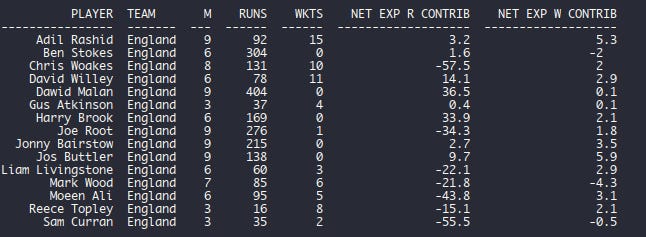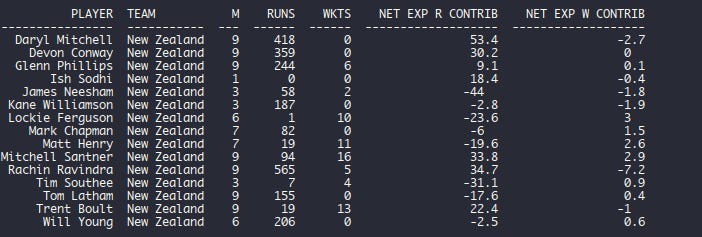A Review Of The 2023 World Cup
As the tournament enters its lottery phase, a review of the league for each team
There are two finite resources available to a team in any innings of ODI match - 10 wickets (winhand) and 300 balls (brem). At the start of each of the 300 balls, these are known exactly. Further, the scoring rate (sr) at the start of each ball is known as well. These three measures describe the state and circumstances of play at the start of each ball. If, for example, a batting side has 9 wickets in hand with 155 balls remaining, and is scoring at 4 runs per over, it tells you one thing, but if it has 9 wickets in hand with 155 balls remaining, and is scoring at 7 runs per over, it tells you another.
Further, on each ball, there are three outcomes:
0 or more runs are scored. (r)
0 or 1 dismissals occur. (d)
0 or 1 legal deliveries are completed. (b)
So, for each ball in a cricket match we have
(sr, winhand, brem) → (r, d, b)
By now, ball by ball (BBB) records are available for 1,657,830 ODI deliveries. Using all this data, it is possible to train a model (there are several ways of doing this, from simple averages to neural networks) which provides the expected runs (EXP RUNS), expected dismissals (EXP DIS) for any ODI delivery given (sr, winhand, brem). If these are compared to the actual runs and dismissal from the delivery, then in the aggregate, we can build a picture of each batter and bowler’s qualities and tendencies. For example, here is the record for IND in the 2023 World Cup league
For example, Virat Kohli scored 594 runs in 9 matches. From the deliveries he faced, the average ODI batter produces 645.2 runs (EXP RUNS). But, the average batter is dismissed 15.6 times over all those deliveries (EXP DIS), whereas, Kohli was dismissed only 6 times. He was 9.6 dismissals better than the average batter (MISB DIS), and 51.2 runs worse (MISBAH). Given that IND chased in five out of nine matches, Kohli (and KL Rahul) have been superbly complementary to Rohit Sharma who was dismissed 0.4 times less often than the average batter, but scored 123.8 runs more than the average batter manages from all the deliveries he faced.
On the 192 balls bowled by Mohammed Shami, the average bowler would have conceded 122.3 runs (EXP RC) for 4.7 wickets (EXP W). Shami took 16/153.
“NET EXP R CONTRIB” gives the net runs contribution with bat and ball. A +ve figure here means the player’s contribution in terms of runs is above average.
“NET EXP W CONTRIB” gives the net wickets contribution with bat and ball. A +ve contribution for a bowler is above average, while a negative contribution for a batter is above average. It is given by JOGI_W + MISB DIS.
One way to think of this is that in terms of dismissals (taking opposition wickets or conceding wickets to the opposition), Virat Kohli (-8.7) and Mohammed Shami (+12.9) have been IND’s most lethal performers. In terms of runs, Jasprit Bumrah (48.6 runs better than the average), and Rohit Sharma (123.8 runs better than average) have been IND’s most lethal contributors.
The table above gives all sorts of details of the record. Here’s a version which is easier to read. This summary table is also given for the other 9 times below.
ENG:
Far too many of their players were in bad runs and had middling returns. Joe Root, who was to do for ENG what Kohli does for IND after Bairstow has done for them what Rohit Sharma does for IND, was 34.3 runs below par, but he was dismissed more often than the average batter.
ENG’s core problem though, was that they didn’t have bowlers who could take wickets in the middle 30 overs when only 4 fielders are permitted outside the inner ring. ENG conceded 4.1/170.0 on average over those 30 overs. Only BAN (3.3/178.4) and PAK (3.5/185.5) were worse.
AUS:
To see AUS’s record in this World Cup, consider ENG’s record and then imagine that their power hitters and batters had better returns, and that they had a top leg spinner to get batters out in the middle overs. Adam Zampa’s 22 wickets put him 10.5 dismissals above par for the league. Both Glenn Maxwell and Mitchell Marsh played great innings. The basic quality of Hazlewood, Cummins and Starc meant that they were almost always in the game.
SA:
South Africa have been the heavy metal team of this World Cup. Their batting has been power packed and their bowling has been varied and deep. In Marco Jansen they have a superb all rounder who can bowl with the new ball. Their fast bowling is quick, and their spinner - Keshav Maharaj - is accurate. It is tempting to think of SA as a team in primary colors constructed on pure power and speed with bat and ball, but that would do a disservice to the artfulness of Jansen, Maharaj, van der Dussen and Bavuma.
NZ:
NZ have been the great survivors of the league. They’ve had to carry injuries, but they’ve invariably found a way to compete efficiently. They have not had the outrageous power or speed of SA, or the extraordinary individual efforts of AUS. NZ have class in their top order, power in the middle and accuracy with the ball without any of those being of the outrageous technicolor variety. Rachin Ravindra is a batter, not a hitter. As is Devon Conway. But both of them have demonstrated that they’ve cultivated shots which can be played to undefended boundaries in ODI matches. In Mitchell Santner, they have a genuine banker of a bowler whose returns are invariably an accurate barometer of the conditions.
PAK:
PAK’s problem, uncharacteristically, has been a general absence of quality. The absence of Naseem Shah (all 9 matches) and Fakhar Zaman (5/9 matches) deprived them of ballast with ball and bat which they could ill afford to lose. If we consider the four qualities whose presence in adequate quantities make up a complete ODI side under the current rules - power and class with the bat, and accuracy and incisiveness with the ball, then PAK were underpowered with the bat and neither accurate nor incisive with the ball for enough of the 50 overs. Their final position in the league table flattered them. PAK 2023 were lucky to finish fifth, while PAK 2019 were unclucky to do so.
SL:
SL were a more limited version of PAK above in this World Cup. Part of this has to do with their relative inexperience. Their most promising players are still young - Theekshana (23), Madushanka (23), Pathirana (20), Wellalage (20), Nissanka (25), Kumara (26), Asalanka (26), Samarawickrama (28) and Mendis (28) will all probably be better players by 2027. The great veteran Angelo Mathews has almost certainly played his last ODI World Cup.
BAN:
BAN were arguably the disappointment of the World Cup. With their spin bowling resources backed by the experience of Mustafizur Rahman and Taskin Ahmed, and the experience in their batting lineup, I felt they would have to do poorly to miss the Semi Finals. As it turned out, their batting was underpowered, and their bowling lacked that one incisive bowler who could be thrown the ball to get a wicket. BAN were epitomised, perhaps, not by the great Shakib Al Hasan, but by Mehidy Hasan Miraz - not quite the same quality or power with bat or ball as his southpaw captain.
NED:
NED qualified ahead of Zimbabwe, West Indies and Ireland, three full members with Test playing privileges. They produced the upset of the tournament by beating South Africa. They did not provided every opponent the expected win. They commanded better treatment and support than they got during this tournament, and are owed a better deal in the coming years.
AFG:
It is debatable whether AFG should have been at this World Cup. In fact, it is debatable whether they should be allowed to play given that their home country denies women the right to play cricket (and whole lot of other rights). South Africa were rightly banished for similar arbitrary exclusions in 1970. Individual South African players were still able to play in leagues all over the world (as individual AFG players should today). But, they were here. And they were superb on the field.
AFG were the team I thought BAN would be at this World Cup. Their batting is underpowered, but their bowling, with the quartet of Noor Ahmad, Mujeeb Ur Rahman, Rashid Khan and Mohammad Nabi were a handful when the conditions challenged them. But for Glenn Maxwell’s miraculous double hundred they would have finished the World Cup having beaten SL, PAK, ENG and AUS - a formidable achievement. AFG demonstrated the virtues of percentage play with bat and ball. They did not have any bowler of the quality of Adam Zampa or any batter like Rohit Sharma, but they were invariably competent without being explosive.
It has been a fine tournament so far. The conditions have been excellent and varied without being excessively one thing or another. Pitches have offered assistance for seam, spin and bat.
IND have beaten all comers. They’ve been more complete for the conditions on hand than any other team I can think of. Perhaps the AUS side of the mid-2000s when Andrew Symonds was at his peak and McGrath and Warne were still playing comes close. They have now won 30 of their last 35 World Cup ODI matches (2011, 2015, 2019 and 2013), and lost 4. It has been a period of extraordinary dominance by an IND side which has improved consistently and sought to commit efficiently since they last won the World Cup in 2011. It will be an upset if they don’t win it again in 2023.














Interesting analysis!
You explain that NET EXP W CONTRIB = EXP DIS + MISB DIS, but this doesn't seem to match the values in the India table at the beginning. Is there an error in the explanation?
Partly because I don't understand this calculation - if a positive value of NET EXP W CONTRIB is good for bowlers, and a negative value is good for batters, how should we think about these values in all rounders?
(sr, winhand, brem) → (r, d, b) is very simplistic because you don't say the part aloud of "all else being equal". The quality of opposition bowling or batting are the hidden variables that just cannot be averaged out.